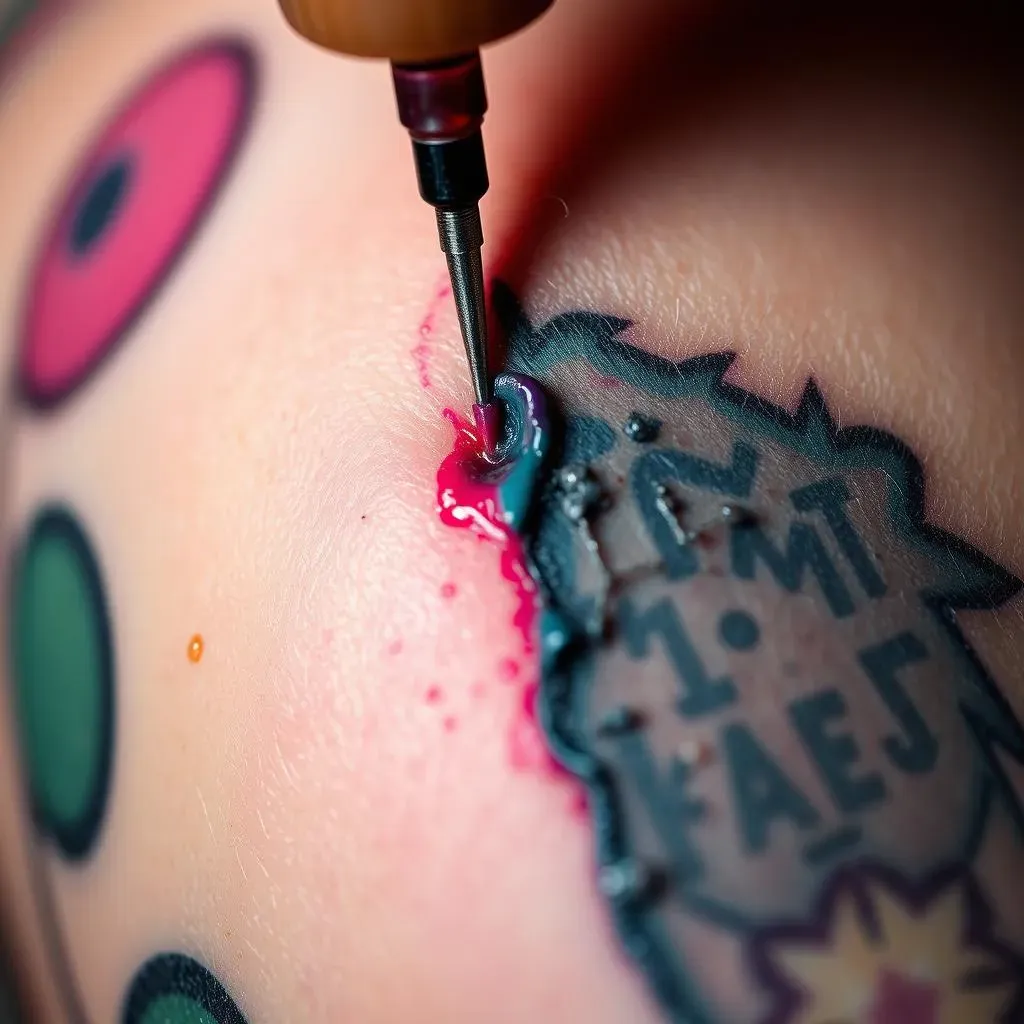Table of Contents
So, you've got some fresh ink, or maybe you're just daydreaming about your next piece. One question that inevitably pops up is: when do tattoos fade? It's a valid concern! No one wants their awesome artwork to turn into a blurry mess. Tattoos are an investment, and like any investment, you want to protect it. This article dives deep into the world of tattoo longevity, exploring the many factors that influence how well your tattoo holds up over time. We'll break down everything from ink quality and placement to aftercare and lifestyle choices. Think of it as your ultimate guide to keeping your tattoos looking fresh for years to come. Ready to learn how to defy the fade? Let's get started and ensure your body art remains a vibrant expression of you!
Factors Influencing How Quickly Tattoos Fade
Factors Influencing How Quickly Tattoos Fade
Alright, let's dive into what makes tattoos fade faster than a summer tan. It's not just about time; several sneaky culprits are at play here. Think of it like this: your skin is constantly renewing itself, shedding old cells and making new ones. Tattoo ink sits in the dermis, the layer beneath the surface, but it's still affected by what's happening above. One of the biggest factors is sun exposure. UV rays are brutal on tattoo ink, breaking down the pigment over time. That vibrant color you loved? UV rays are not a fan. Then there's your skin itself. How well it holds onto ink depends on genetics, skin type, and even how well hydrated you are. Lifestyle choices also play a significant role; smoking, excessive alcohol consumption, and poor diet can all impact your skin's health and, consequently, your tattoo's appearance.
Ever wondered why some tattoos stay sharp while others blur?
- Sun Exposure: UV rays are the enemy.
- Skin Hydration: Dry skin fades tattoos faster.
- Lifestyle: Smoking and poor diet accelerate fading.
Tattoo Placement: Impact on Fading and Longevity
Tattoo Placement: Impact on Fading and Longevity
The Prime Real Estate of Tattooing: Where to Ink?
so you're ready for some ink, but where on your body should you put it? Tattoo placement is a HUGE deal when it comes to fading. Think about it: some areas get way more exposure to the elements than others. Areas that experience a lot of friction, like your hands or feet, tend to fade faster because the skin cells regenerate more quickly there. Similarly, spots that are constantly exposed to the sun, like your shoulders or the back of your neck, are prime targets for UV damage, which, as we've already established, is a tattoo's worst enemy. So, before you commit to that intricate design, consider how much wear and tear that particular spot endures.
Did you know that tattoos on your fingers and palms fade super quickly?
- High-Friction Zones: Hands, feet, and areas under clothing straps.
- Sun-Exposed Areas: Shoulders, back of the neck, and tops of feet.
- Areas with Frequent Skin Movement: Joints like elbows and knees.
Strategic Spots: Maximizing Tattoo Lifespan
Now, let's talk about the sweet spots – the areas where tattoos tend to hold up better over time. Generally, areas with thicker skin and less sun exposure are your best bet. Think about your upper arms, thighs, or back. These areas are shielded from the sun more often and don't experience as much friction as other parts of your body. Also, consider the natural contours of your body. Placing a tattoo on a part of your body that stretches and moves a lot can cause the ink to distort and fade over time. So, a little planning goes a long way in ensuring your tattoo stays vibrant and crisp for years to come.
Ever wonder why back tattoos seem to last forever?
Placement | Fading Rate | Considerations |
|---|---|---|
Upper Arms/Thighs | Slow | Less sun exposure, thicker skin. |
Hands/Feet | Fast | High friction, frequent washing. |
Back/Chest | Moderate | Relatively stable skin, but sun exposure can be a factor. |
Tattoo Ink Quality and Its Role in Fading
Tattoo Ink Quality and Its Role in Fading
The Pigment Predicament: Not All Inks Are Created Equal
Ever wondered why some tattoos look amazing for decades, while others fade faster than a cheap t-shirt? A huge factor is tattoo ink quality. Seriously, it's like the wild west out there when it comes to ink. Some manufacturers use high-grade pigments that are designed to last, while others... well, let's just say they prioritize profit over vibrancy. Cheaper inks often contain lower-quality pigments that break down more easily when exposed to sunlight or the body's natural processes. Plus, some inks are more prone to migration, meaning they spread out under the skin, leading to a blurry, faded look. So, do your research! Ask your artist about the brands they use and look for reputable names known for their longevity.
Think of it like buying paint for your house – you wouldn't go for the cheapest option if you wanted it to last, right?
- Pigment Quality: Higher quality = longer lasting.
- Ingredient Stability: Stable ingredients resist breakdown.
- Brand Reputation: Research reputable ink brands.
Color Matters: How Shades Affect Fading
Believe it or not, the color of your tattoo ink can also impact how quickly it fades. Lighter colors, like yellows, pastels, and whites, tend to fade faster than darker colors like black and deep blues. This is because lighter pigments have less density and are more susceptible to being broken down by UV rays. Black ink, on the other hand, is the most stable and long-lasting, which is why traditional blackwork tattoos often hold up so well over time. That doesn't mean you should avoid lighter colors altogether, but it's something to keep in mind when designing your tattoo. If you're set on a pastel masterpiece, be extra diligent about sun protection and aftercare to maximize its lifespan.
Did you know that red ink is notorious for causing allergic reactions?
Ink Color | Fading Rate | Considerations |
|---|---|---|
Black | Slowest | Most stable and durable. |
Dark Blues/Greens | Moderate | Good longevity, but can still fade over time. |
Reds/Oranges | Moderate to Fast | Can be prone to fading and allergic reactions. |
Yellows/Whites | Fastest | Least dense, most susceptible to UV damage. |
Aftercare's Impact: Preventing Premature Tattoo Fade
Aftercare's Impact: Preventing Premature Tattoo Fade
The Golden Rule: Following Artist Instructions
you've got this amazing new tattoo, and you're stoked. But here's the thing: the immediate aftercare is absolutely crucial in preventing premature tattoo fade. Seriously, it's not just some suggestion; it's the golden rule! Your tattoo artist knows their stuff, so listen up when they give you aftercare instructions. They'll tell you how long to keep the bandage on, how often to wash the tattoo, and what kind of ointment to use. Following these instructions to the letter is essential for proper healing and long-term vibrancy. Think of it as laying the foundation for a lifetime of awesome ink.
Ever skipped aftercare and regretted it later?
- Keep it Clean: Gently wash with mild soap.
- Moisturize Regularly: Use a recommended ointment.
- Avoid Picking: Let scabs fall off naturally.
Sunscreen is Your Tattoo's Best Friend
We've already talked about how UV rays are the enemy of tattoos, so it should come as no surprise that sunscreen is your tattoo's best friend. Once your tattoo is fully healed, make sunscreen a non-negotiable part of your daily routine, especially if your tattoo is in a sun-exposed area. Look for a broad-spectrum sunscreen with an SPF of 30 or higher, and apply it generously and often. This will create a barrier between your tattoo and those damaging UV rays, helping to prevent fading and keep your colors looking vibrant for years to come. Trust me, your future self will thank you!
Think of sunscreen as a shield against tattoo doom!
Product | Benefit | Application |
|---|---|---|
Broad-Spectrum Sunscreen (SPF 30+) | Protects against UV damage | Apply liberally 15-30 minutes before sun exposure, reapply every 2 hours. |
Tattoo Balm | Keeps skin moisturized and promotes healing | Apply a thin layer 2-3 times daily after washing. |
Long-Term Care: Habits for Tattoo Longevity
Aftercare isn't just for the initial healing period; it's a long-term commitment to preventing premature tattoo fade. Maintaining a healthy lifestyle can also contribute to the longevity of your tattoos. Staying hydrated, eating a balanced diet, and avoiding smoking can all improve your skin's overall health and help your tattoos look their best. Also, be mindful of activities that can damage your tattoos, such as excessive scrubbing or exposure to harsh chemicals. Treat your tattoos with the same care you would any other valuable piece of art, and they'll reward you with years of vibrant color and crisp lines.
Remember, a happy body equals a happy tattoo!
Touching Up Faded Tattoos: Restoring Your Ink
Touching Up Faded Tattoos: Restoring Your Ink
Is It Time for a Refresh? Recognizing Fade
so you've done everything right – you followed aftercare instructions, slathered on the sunscreen, and lived a relatively healthy life. But alas, time marches on, and even the best-cared-for tattoos can start to fade. How do you know when it's time for a touch-up? Look for telltale signs like dullness in colors, blurred lines, or an overall lack of vibrancy. Sometimes, the fading is subtle, and you might not notice it until you compare your tattoo to a photo from when it was fresh. Other times, it's glaringly obvious that your once-bold design has lost its punch. The key is to be observant and realistic about the natural aging process of tattoos.
Ever caught a glimpse of your tattoo in the mirror and thought, "Wait, was that line always so fuzzy?"
Before you start thinking about a touch-up, make sure it's not just dry skin making your tattoo look dull! Exfoliate gently and moisturize to see if that brings back some of the vibrancy.
The Touch-Up Process: What to Expect
So, you've decided it's time to give your faded friend some love. What can you expect from the touch-up process? Well, it's generally much quicker and less intense than getting the original tattoo. Your artist will go over the existing lines and colors, reinforcing them and restoring their original vibrancy. In some cases, they might also make minor adjustments to the design or add new elements to enhance the overall look. Be sure to communicate clearly with your artist about your expectations and any specific areas you want them to focus on. And remember, proper aftercare is just as important for a touch-up as it was for the initial tattoo!
Think of a touch-up like a spa day for your tattoo – a little refresh and rejuvenation!
Touch-ups can also be a great opportunity to correct any minor imperfections that might have appeared over time, like small gaps in the linework or uneven shading.
Choosing the Right Artist for the Job
Just because an artist gave you a great tattoo the first time doesn't necessarily mean they're the best choice for a touch-up. It's important to find an artist who has experience with touch-up work and a good understanding of how tattoos age over time. Look for someone who is meticulous, detail-oriented, and willing to work with you to achieve the desired result. Don't be afraid to ask to see examples of their touch-up work and read reviews from other clients. A skilled touch-up artist can make all the difference in restoring your tattoo to its former glory.
Ever seen a bad touch-up that made a tattoo look even worse? Yeah, it's worth doing your research!
Factor | Considerations |
|---|---|
Experience | Look for artists with specific touch-up experience. |
Portfolio | Review their work to ensure quality. |
Communication | Choose someone who listens to your concerns. |
Preserving Your Ink: A Lasting Impression
Understanding when do tattoos fade and the steps you can take to prevent it is crucial for maintaining the vibrancy of your body art. From choosing the right placement and ink to diligently following aftercare instructions and protecting your skin from the sun, every decision counts. While some fading is inevitable over time, proactive care and occasional touch-ups can ensure your tattoos continue to tell your story for years to come. So, embrace the art, cherish the process, and take the necessary steps to keep your ink looking its best.